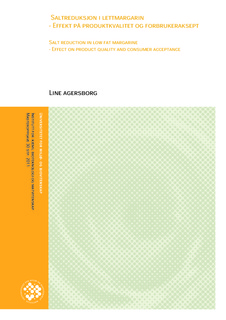Saltreduksjon i lettmargarin : Effekt på produktkvalitet og forbrukeraksept
Master thesis
Permanent lenke
http://hdl.handle.net/11250/186325Utgivelsesdato
2012-05-29Metadata
Vis full innførselSamlinger
- Master's theses (KBM) [890]
Sammendrag
Hovedhensikten med denne oppgaven var å se på hvor godt forbrukere liker lettmargarin når
salt i form av natriumklorid er redusert og erstattet av kaliumklorid. Dette ble gjort på
bakgrunn av ønske om å minke NaCl- innhold i industriprodusert mat da vi får i oss mer en
dobbelt så mye salt som anbefalt fra helsemyndighetene. Følgende saltkonsentrasjoner ble
testet ut:
· 100 % NaCl (Referansemargarin, 1,3 % salt)
· 50 % NaCl
· 50 % NaCl 25 % KCl
· 50 % NaCl 50 % KCl
Prøvene ble servert på loff, og forbrukerne ble bedt om å angi hvor godt de likte de ulike
variantene på en skala fra 1 til 9. Resultatene fra forbrukerundersøkelsen viste at
referansemargarinen kom best ut, så vidt bedre likt enn varianten med 50 % NaCl 25 % KCl.
Den dårligst likte varianten, var den med 50 % NaCl, så deltakerne i forbrukerundersøkelsen
foretrekker et innhold på 50 % NaCl 50 % KCl framfor kun 50 % NaCl.
Ut fra analysene gjort for å teste kvaliteten på margarinvariantene, så en at utover endringer i
smak, påvirket mengde og type salt også pH og viskositet på vannfasen. Referansemargarinen
er produsert i fabrikk, mens de saltreduserte prøvene ble produsert i pilotanlegg. Margarinene
som var produsert i pilot hadde dårligere kvalitet enn den fabrikkproduserte margarinen. Dette
skyldes i hovedsak at vi ikke hadde like optimale prosessbetingelser i pilot som i fabrikk og
dette ga margariner som var grovere, mer åpne og med mykere konsistens enn margarinen
produsert i fabrikk.
Margarinene ble også karakterisert i en kvalitativ test av et trenet sensorisk panel hos Nofima
Mat. Selv om lettmargarinene som innehold kaliumklorid hadde signifikant mer bittersmak
enn de uten, ser ikke dette ut til å påvirke forbrukernes liking. Funnene i denne oppgaven
tyder på at vil være realistisk å redusere saltinnholdet i lettmargarin med 50 % ved å erstatte
50 % NaCl med 25 % KCl uten at dette påvirker likingen hos forbrukerne i noe særlig grad.
Det bør gjøres videre undersøkelser på lavsalt lettmargarin produsert i fabrikkskala for å bekrefte funnene i denne oppgaven. The aim of this master thesis was to produce and see how well consumers like low fat margarine when salt in form of sodium chloride was reduced and replaced by potassium
chloride. This was done based on the purpose of reducing the NaCl content of industrially
prepared food since we consume more than twice as much salt as recommend by health
authorities. The following salt concentrations were tested:
· 100 % NaCl (Reference margarin with 1,3 % NaCl)
· 50 % NaCl
· 50 % NaCl 25 % KCl
· 50 % NaCl 50 % NaCl
The samples for consumer testing were served on white bread, and the participants were asked
to indicate how well the liked the different varieties and how strongly they experienced the
flavor intensity. They were also asked to describe the taste of the samples in their own words.
The results of the consumer survey showed the reference margarine came out best, and the
sample with 50 % NaCl 25 % KCl was the 2nd best liked sample. The sample with only 50 %
NaCl was the least liked sample. The consumers preferred a content of 50 % NaCl 50 % KCl
instead of only 50 % NaCl.
Based on the analysis done to test the quality of the margarine samples, it was noticed the in
addition to change in tastes, salt reduction also influenced the pH and the viscosity. The
reference margarine is produced in the factory, while the salt reduced samples were produced
in a pilot plant. The latter samples had poorer quality. This is mainly because that it wasn’t
optimal process condition in the pilot plant, and these samples had a rougher, more open and
softer texture than the sample produced in the factory.
There was done a sensory evaluation at Nofima Mat, and low fat margarine containing
potassium chloride was reported significantly more bitter than those without. This does not
seem to influence the consumers liking. This study showed that it could be realistic to reduce
the salt content in low fat margarine with 50 % by replacing 50 % NaCl with 25 % KCl.
Futher studies on margarine produced in factory should be carried out to strengthen these claims.
